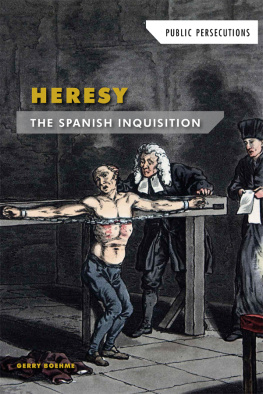HERESY AND THE MAKING OF EUROPEAN CULTURE
Heresy and the Making of European Culture
Medieval and Modern Perspectives
Edited by
ANDREW P. ROACH and JAMES R. SIMPSON
University of Glasgow, UK
First published 2013 by Ashgate Publishing
Published 2016 by Routledge
2 Park Square, Milton Park, Abingdon, Oxon OX14 4RN
711 Third Avenue, New York, NY 10017, USA
Routledge is an imprint of the Taylor & Francis Group, an informa business
Copyright Andrew P. Roach and James R. Simpson 2013
Andrew P. Roach and James R. Simpson have asserted their right under the Copyright, Designs and Patents Act, 1988, to be identified as the editors of this work.
All rights reserved. No part of this book may be reprinted or reproduced or utilised in any form or by any electronic, mechanical, or other means, now known or hereafter invented, including photocopying and recording, or in any information storage or retrieval system, without permission in writing from the publishers.
Notice:
Product or corporate names may be trademarks or registered trademarks, and are used only for identification and explanation without intent to infringe.
British Library Cataloguing in Publication Data
A catalogue record for this book is available from the British Library
The Library of Congress has cataloged the printed edition as follows:
Heresy and the making of European culture : medieval and modern perspectives / [edited]
by Andrew P. Roach and James R. Simpson.
pages cm
Includes bibliographical references and index.
ISBN 978-1-4724-1181-5 (hardcover)
1. Christian heresies History Middle Ages, 6001500. 2. Europe Church history 6001500. 3. Civilization, Medieval. I. Roach, Andrew P., author, editor of compilation. II. Simpson, James R., 1964- author, editor of compilation.
BT1319.H473 2013
273.094dc23
2013005999
ISBN 9781472411815 (hbk)
Contents
Andrew P. Roach and James R. Simpson
Kallistos Ware
Maribel Fierro
Alexander Murray
Marilyn Dunn
Julien Bellarbre
Maja Angelovska-Panova and Andrew P. Roach
Judith R. Anderson
Catherine Lglu
Sieglinde Hartmann
James R. Simpson
Claire Taylor
Peter Petkoff
Daniel Gerrard
Alessandra Beccarisi
Eva Dolealov
Sarah Thomas
James Given
Igor Dorfmann-Lazarev
Faye Taylor
Georg Modestin
Philip Tonner
John M. Bates
Robert I. Mochrie
List of Illustrations and Table
Illustrations
Table
Note on Cover Illustrations
We were drawn to Frank Craigs painting of The Heretic from 1906 for a number of reasons, not least because it was not one of the regular canon of images used to illustrate books on medieval heresy. It was also, although a century old, a modern take on a medieval subject, the theme of some of the chapters in this collection. Craigs title was ironic. The following year he exhibited a companion piece, The Maid, which was to become more famous. It showed the same woman leading a cavalry charge. The heretic was revealed to be Joan of Arc. It was a striking gesture for an English artist to portray the English persecution, complete with inquisitors, of a French saint, possibly as a response to the historic change in Anglo-French relations begun with the Entente Cordiale of 1904. The painting is a subtle one; highlighted and foregrounded is the isolation of the heretic from those around her in terms of gender, age, wealth and social status. Her only clothing is a blank, white cloth which both masks her true form and suggests an empty space on which observers can project their own beliefs. Finally, there is the crowd; Craig creates a troublingly trans-historical perspective. Critics have detected a self-portrait and figures in twentieth century dress among them; attitudes towards the woman at the centre range from sympathy, to hatred and indifference. And Craig makes it clear that the woman is surrounded; on three sides by contemporary persecutors, observers and anachronistic arrivals from the artists time and on the fourth by you, the reader or viewer, from your own.
The back cover illumination taken from the early fourteenth-century Maastricht Hours (British Library, Stowe 17) provides a satirical vision of the human world of religious culture. The image of the fox preaching to poultry appears in manuscript illumination as well as carvings in many medieval churches. Of course, at the same time, what is clear from the marginal or hidden presence of this particular topos in manuscripts and misericords is that it also serves as a warning regarding misuses within the Church. We might note that this affluent fox has chosen to clothe himself in the colours of the text, his blue cloak the same rich shade as the lettrines above.
For images and commentary, see notably Kenneth Varty, Reynard the Fox (Leicester: Leicester University Press, 1962).
On the use of foxes as an image by Bernard and others, see especially L.J. Sackville, Heresy and Heretics in the Thirteenth Century: The Textual Representations (Woodbridge: York Medieval Press; Boydell, 2011), pp. 15660.
List of Abbreviations
Primary Sources
BNF | Paris, Bibliothque nationale de France |
Biller, Bruschi, Sneddon (eds), Inquisitors | Biller, Peter, Carla Bruschi and Shelagh Sneddon (eds), Inquisitors and Heretics in Thirteenth-Century Languedoc: Edition and Translation of Toulouse Inquisition Depositions, 127382 (Leiden: Brill, 2011) |
MGH | Monumenta Germaniae Historica
Auct. Ant. = Auctores Antiquissimi
Poetae = Poetae latini aevi carolini
Scriptores = Scriptores |
PG | Patrologia Graeca, ed. J.-P. Migne and others (161 vols, Paris: Imprimerie Catholique, 185766) |
PL | Patrologia Cursus Completus Series Latina, ed. J.-P. Migne and others (221 vols, Paris: Migne; Garnier, 184455) |
Glaber: Opera | Rodulfus Glaber: Opera, ed. and trans. John France, Neithard Bulst and Paul Reynolds, Oxford Medieval Texts (Oxford: Clarendon, 1989) |
Wakefield and Evans, Heresies | Heresies of the High Middle Ages, ed. Walter L. Wakefield and Austin P. Evans, Records of Civilisation: Sources and Studies, 81 (New York: Columbia University Press, 1969) |
AASS | Acta Sanctorum, ed. Societas Bollandiensis, vol. Jan. IOct. XI, 3rd edn (Paris, 186370); vol. Oct. XIINov. IV (Brussels, 18671925) |









